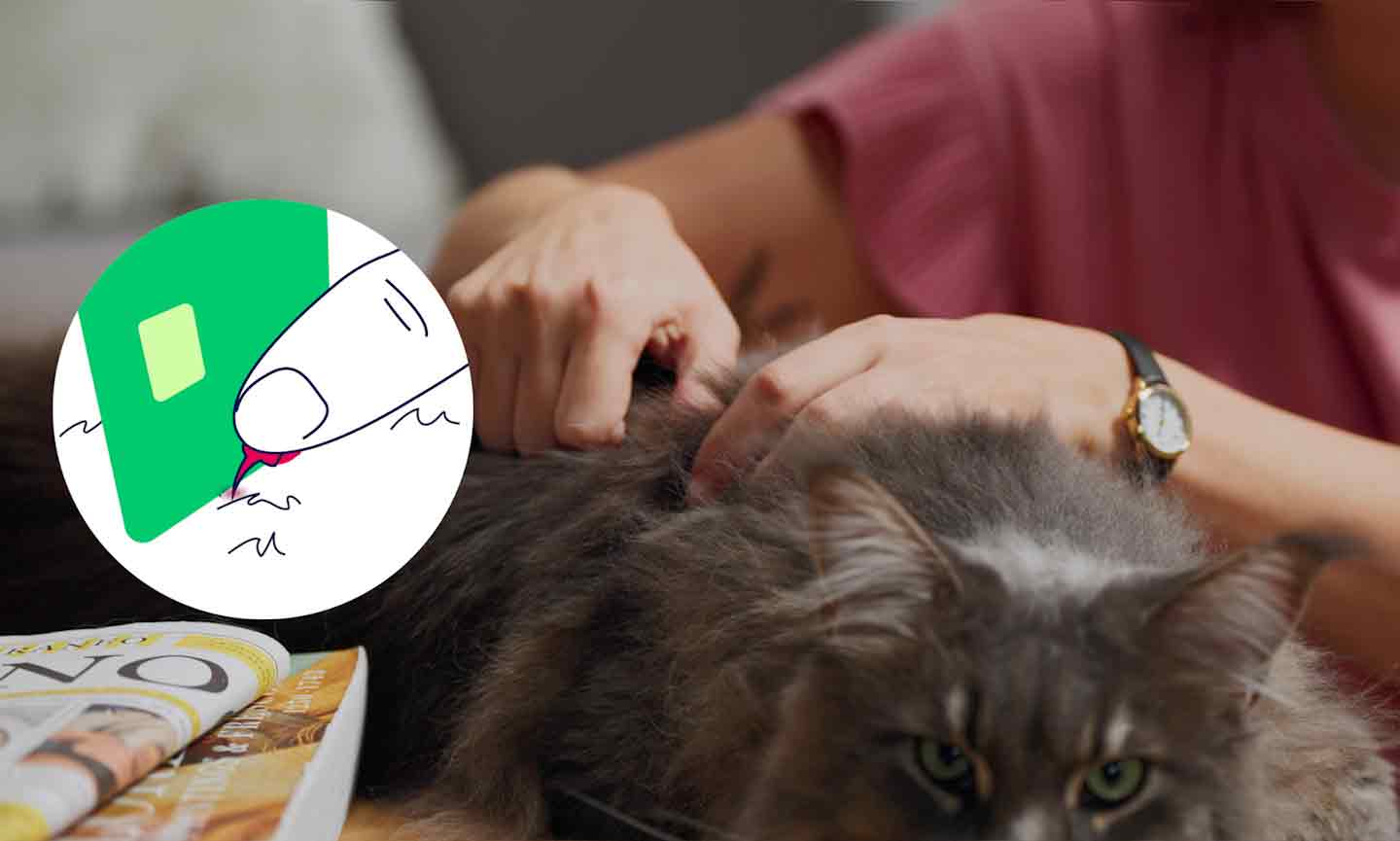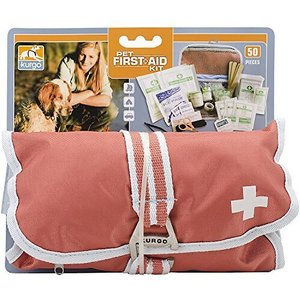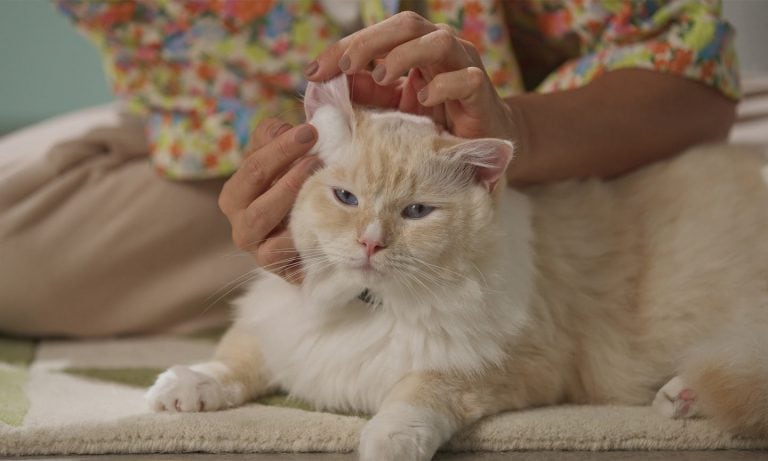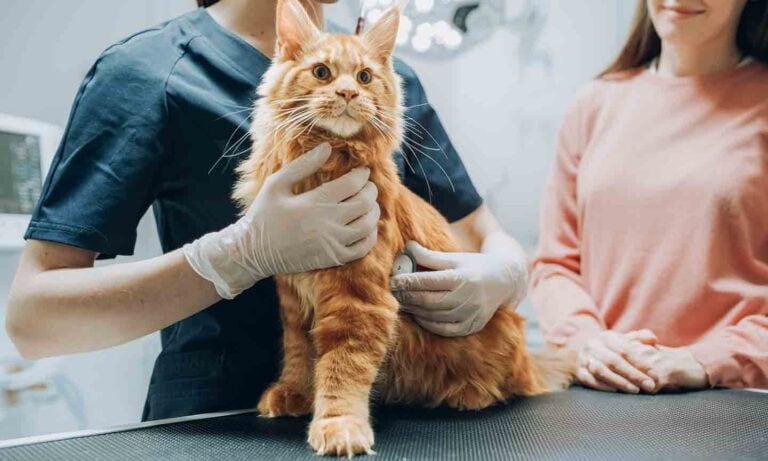In This Guide:
Signs That Your Cat Has Been Stung by a Bee or Wasp
While some cats might get stung and have little reaction, others might be scared merely by seeing a bee in the house. Here are some signs to look for if you believe your cat has been stung:
- Swelling: Like humans, cats experience redness and mild swelling at the site of a bee or wasp sting.
- Pawing at the face: According to Dr. Hockaday, cats’ most common areas for stings are their paws and face, because those are what they use to investigate things. With stings on the face, head or neck, you also want to watch for allergic reactions that could restrict breathing.
- Flinging a paw: If your cat has been stung in the paw, they might flip the paw in the air repeatedly. Your cat may also start limping.
- Licking an area: Your cat may be trying to relieve pain in the affected area by excessively grooming or cleaning it.
- Itching or scratching: Instead of licking, your cat may try to feel better by scratching the affected area.
Signs Your Cat Is Having an Allergic Reaction to a Sting
Within the first 15 minutes and up to 24 hours after being stung, your cat can experience an allergic reaction. It’s important to monitor your cat during this time for signs of a reaction, even if your cat has been stung before and seemed fine. Sometimes, a life-threatening allergic reaction can build up over multiple bee or wasp stings.
Signs of an allergic reaction that require treatment include:
- Severe swelling
- Weakness and collapsing
- Hives
- Vomiting
- Diarrhea
- Drooling
- Changes in breathing, especially difficulty breathing
- Disorientation
- Pale gums
- Hissing and/or growling
- Seizures
An allergic reaction often begins with swelling around the site of the sting. For many cats, the reaction usually doesn’t go beyond this stage—but it’s a good idea to watch your cat for the next 24 hours to ensure their symptoms don’t progress. Put your cat in a quiet, enclosed space, like a bathroom, where you can stay with them and observe them to be sure they don’t experience any further symptoms.
If your cat’s symptoms escalate—including severe swelling, weakness or pale gums—they may be experiencing anaphylaxis, a severe, life-threatening allergic reaction. Immediately seek emergency treatment. This is especially important if your cat is experiencing difficulty breathing. Swelling can restrict their breathing if your cat has been stung on the face, head or neck. If your cat has any trouble breathing, go directly to an emergency veterinarian.
What To Do When Your Cat Has Been Stung
1Stay Calm
It can be hard to remain calm when your furry friend is in pain, but keeping your cool will help your cat be less stressed. Take them to a safe and quiet place where you can investigate the sting. Typically, a small, enclosed space like a bathroom works well. This will help keep you and your cat safer during the next steps.
2Remove the Stinger
If your cat was stung by a bee, you can try to remove the stinger from the wound. Dr. Hockaday recommends using a credit card to extract the bee stinger. Scrape it across the site of the sting to catch the stinger and pull it up and out of the wound.
What not to do: Don’t squeeze the affected area. This can cause more venom to penetrate into your cat’s skin tissue, making the sting more painful for your cat.
3Apply Cool Water and Ice (Optional)
After removing the stinger, rinse the affected area with cool water or treat it with a cold compress.
Next, prepare an ice pack and test it on yourself using a barrier like a towel or T-shirt to make sure it’s not too cold for your cat. Never apply ice or an ice pack directly to your pet’s fur or skin, as this can cause tissue damage. Once you’ve determined it’s OK, apply the covered ice pack to your cat’s sting for 10 minutes to help reduce swelling.
Cool water and ice can help reduce swelling and pain at the site of the sting—but if your cat is too stressed or upset, they may not appreciate this step (and may use claws or teeth to show it). If your cat just isn’t having it, it’s OK to skip this step.
4Monitor Your Cat
Watch your cat for signs of an allergic reaction for 24 hours after the incident. Try to prevent them from licking or scratching at the sting site too. If they’re not exhibiting emergency symptoms, make sure they have fresh water to keep them hydrated and in a stress-free environment so they can rest and relax.
5Contact Your Veterinarian
Even if your cat didn’t have a severe allergic reaction, you should let your vet know they were stung. If you know what type of insect sting it was, include that information too. That way, it’s in their medical record for the future. Dr. Hockaday also recommends discussing an action plan for emergencies (like insect stings) during your annual visit.
Can I Use Home Remedies for Bee Stings or Wasp Stings on My Cat?
As long as your cat doesn’t have any emergency symptoms, it’s fine to treat them with the following home remedies:
- An ice pack (wrapped in a towel), as described above, to relieve swelling around the sting
- Antihistamines: Call your veterinarian and ask if you should give your cat an antihistamine, such as diphenhydramine (Benadryl, Vetadryl). Some human products, including some versions of Benadryl, can contain alcohol or additional medications that may be harmful to cats. Once you know the correct medication and dose for your cat, you can keep some in your pet first aid kit.
FAQs About Bee Stings and Wasp Stings on Cats
Q:How quickly will a cat react to a bee sting?
A:You may notice your cat reacting in pain to a sting within seconds. However, an allergic reaction can take anywhere from 15 minutes to several hours to fully develop. That’s why you should closely monitor your cat for up to 24 hours if you suspect they have been stung.
Q:Should I give my cat Benadryl® for a bee sting?
A:Do not give your cat any medication before discussing it with your veterinarian. Some medicines can be poisonous to cats, and others are only safe when given in the correct dosage.
Q:How dangerous is a wasp sting for cats?
A:Wasp stings aren’t usually dangerous to cats, but they can be painful. In less-common cases, wasp stings can cause a life-threatening allergic reaction in your cat. Monitor your cat for symptoms like severe swelling and difficulty breathing, and visit your vet immediately if you suspect they are having a severe allergic reaction.
Q:How do I know if my pet is going into anaphylactic shock?
A:Within 15-20 minutes, your cat might show signs of anaphylaxis, including swelling, weakness or pale gums. The most extreme reaction you need to watch out for is difficulty breathing. If your cat was stung on the face, head or neck, they may be having difficulty breathing, and you should seek emergency veterinary care immediately.
By quickly recognizing the signs and symptoms of an allergic reaction, you can help reduce any risks to your cat’s health after an insect sting. As a pet parent, it’s important to be informed about the proper use of home remedies and to consult your veterinarian about emergency care so your cat can be safe and healthy even while they stay curious about the world.
This content was medically reviewed by Chewy vets.
Share:





















